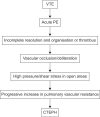Pulmonary arterial hypertension and chronic thromboembolic pulmonary hypertension: pathophysiology
- PMID: 20956167
- PMCID: PMC9491634
- DOI: 10.1183/09059180.00007309
Pulmonary arterial hypertension and chronic thromboembolic pulmonary hypertension: pathophysiology
Abstract
Pulmonary arterial hypertension (PAH) and chronic thromboembolic pulmonary hypertension (CTEPH) are two of the key subgroups of pulmonary hypertension. They are characterised by different risk factors. PAH can be associated with mutations in the gene encoding bone morphogenetic protein receptor type II (BMPR2), HIV infection, congenital heart disease, connective tissue disease (such as systemic sclerosis), and exposure to particular drugs and toxins including fenfluramine derivatives. In contrast, CTEPH can be associated with anti-phospholipid antibodies, splenectomy and the presence of a ventriculo-atrial shunt or an infected pacemaker. The first-line therapies used to treat PAH and CTEPH also differ. While medical therapy tends to be used for patients with PAH, pulmonary endarterectomy is the treatment of choice for patients with CTEPH. However, there are possible common mechanisms behind the two diseases, including endothelial cell dysfunction and distal pulmonary artery remodelling. Further research into these similarities is needed to assist the development of targeted pharmacological therapies for patients with inoperable CTEPH and patients who have persistent pulmonary hypertension after endarterectomy.
Figures


References
-
- Simonneau G, Robbins IM, Beghetti M, et al. Updated clinical classification of pulmonary hypertension. J Am Coll Cardiol 2009; 54: Suppl. 1, S43–S54. - PubMed
-
- Humbert M, Sitbon O, Simonneau G. Treatment of pulmonary arterial hypertension. N Engl J Med 2004; 351: 1425–1436. - PubMed
-
- Tuder RM, Abman SH, Braun T, et al. Development and pathology of pulmonary hypertension. J Am Coll Cardiol 2009; 54: Suppl. 1, S3–S9. - PubMed
-
- Humbert M, Sitbon O, Chaouat A, et al. Pulmonary arterial hypertension in France: results from a national registry. Am J Respir Crit Care Med 2006; 173: 1023–1030. - PubMed
Publication types
MeSH terms
LinkOut - more resources
Full Text Sources
Other Literature Sources
Medical
Miscellaneous
